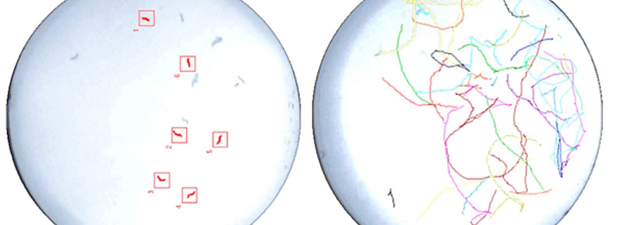
The report file presents quantification results organized into user-defined time-blocks. Initially, it displays the average population results, followed by the individual particle results at the bottom:
Parameters Description:
Average population results:
• #Particles: Represents the average number of particles detected per frame.
• Average speed [mm/s]: Indicates the average speed of all detected particles.
• Travelled distance [mm/particle]: Reflects the total distance travelled by all detected particles, divided by the average number of particles detected per frame.
• Motility score: Denotes the fraction of detection events corresponding to moving particles (distance > 1mm). This score ranges between 0 and 1. Refer to How Motility Score Is Calculated On WMicrotracker SMART
• Rotation Index: Represents the average rotation index of all detected particles.
Single particle results:
Provides a detailed listing of results for each individual particle detected, with a minimum detection duration of 10 frames.
• ID particle: Each particle is assigned a unique identification number based on its order of appearance or recognition.
• Distance: Indicates the total distance travelled by the respective particle.
• #frames: Specifies the number of frames in which the particle was detected. Notably, the device captures one frame per second.
• Speed: Represents the velocity of the particle, calculated as the distance travelled divided by the number of frames in which it was detected (assuming one frame per second).
• Rotation: This index quantifies the change in rotation of animal body shapes. It proves particularly beneficial for lifespan experiments or instances where animals exhibit minimal movements without creating long trails. The rotation index range is from 0 to 16. For a practical example, please refer to How Rotation index Is Calculated On WMicrotracker SMART
FAQ: Why do I see a list of particle trial IDs in the report that is higher than the number of organisms I initially input?
When the software fails to detect an organism’s silhouette for 10 seconds, the path of that particle ends, and the software will assign a new particle ID to that worm when it detects it again.
